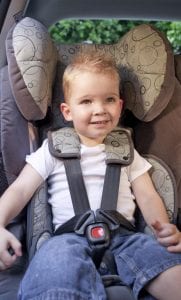Properly used and secured child car seat restraints reduce the risk of death and injury in a motor vehicle crash by approximately 70 percent, yet research indicates that many parents are unsure of what child car restraint they should buy or how to use and install it.
All children under seven years of age must use a child car restraint when travelling in a car in Queensland.
So what is the law about car seats?
- Birth to six months – babies must be rear facing.
- Six months to four years babies can be rear-facing or toddlers forward-facing in a restraint with a built-in harness.
- Four years to seven years – children must use a booster seat with the adult seat belt or a H-harness.
Is this best practice? These laws are the minimum ages, not the safest ages to transition.
For example… Kidsafe says that if the child is small or has not outgrown the appropriate child car restraint there is no need to move to the next level of restraint even though they have reached the minimum transition age. This is extremely important for babies. Most babies at six months should not transition to forward facing – babies are safer rear facing as long as possible. To be forward facing babies must be a minimum of six months, but, more importantly, be able to sit on the floor unassisted with good head control – that is have a strong neck and not topple over.
Tips for babies in a car seat:
- Spine should be at 45 degrees from level.
- Shoulder straps at lowest level should be above baby’s shoulder and between shoulder and ear.
- Gap between baby’s crotch and crotch strap can be filled with rolled washer to prevent a small baby sliding down.
- At correct angle and position baby’s chin should never fall onto chest or loll forward.
- Unswaddle / unwrap the baby before placing in capsule – arms and legs must be positioned through the straps.
- Beware of overheating. The aircon flows over the capsule or restraint, not the baby. Don’t over dress – no beanies. Baby should be dressed in loose, comfortable clothing.
- Kidsafe recommends babies should remain rearward facing for as long as possible. Only consider forward facing when: baby reaches minimum of 6 months of age AND has strong neck and core strength (able to sit unaided for 10-15 min without toppling over PLUS they exceed the maximum weight or height restriction of the particular restraint OR shoulder reaches the minimum height marking*
*Note that any forward-facing child car restraint manufactured after 2011 will have a minimum shoulder height level that the baby must also meet.
Tips for restraints:
Capsule or rear-facing restraint is fitted and perhaps adjusted to the seat so that baby’s back is at 45 degrees from level ground.
No twists in the tether strap, the built in harness straps, or the adult seat belt.
Do not over-tighten the tether strap – take the slack out ONLY. Tether strap should have a little ‘bounce’.
Tether strap must only attach to an appropriate child restraint anchor point. Check your car manual to ensure you are using the correct anchor point.
Built in harness fitted correctly means:
- Built in shoulder straps set at height equal to or slightly above child’s shoulder NEVER BELOW.
- Check the fabric/cushioning in the restraint is not obstructing the position of the shoulder straps.
- No slack in the built in harness – only a 2 finger gap between harness and baby’s collar bone
- Harness should have L shaped fold at buckled on each side – NEVER twisted.
- Minimum allowable gap between the back of the front seat and the baby capsule is one finger’s width. NEVER wedge the back of the front seat against the capsule or rear-facing child car restraint.
A couple of extra tips:
- Underweight or prem babies are safest in the Safe and Sound Baby Safety Capsule.
- Advise your insurance company that you have a child restraint in the vehicle.
- If the vehicle in which your restraint is attached is involved in an accident where there is structural damage to the vehicle, Kidsafe Qld recommends that the restraint be destroyed. This is based on the recommendation by the Standards Committee and the Australian Standard for child car restraints. It is also recommended by the restraint manufacturers.
Kidsafe Qld and manufacturers recommend NOT purchasing second-hand child car restraints.
If you have any doubts about your child’s car restraint contact Kidsafe . Kidsafe’s experienced child car restraint installers will be happy to check that you have the right seat for your child, that it is being used correctly and that it is installed safely.
Kidsafe Queensland is dedicated to the prevention of unintentional injury in children – keeping kids OUT of hospital. Kidsafe is now offering child car restraint hire, checking and installation servi ce sthroughout Queensland so call Kidsafe and reduce the risk of injury to your child. Phone 3854 1829 or visit www.kidsafeqld.com.au


